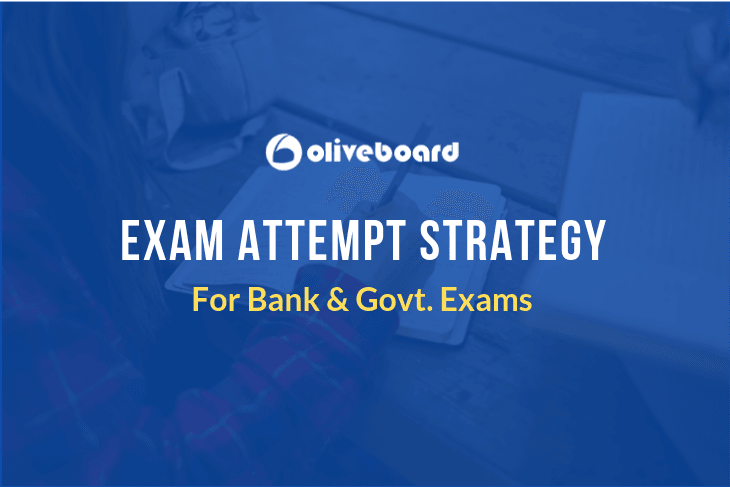As exam season is approaching, all are gearing up to get their dream job this year. But as they say, a vision without a strategy remains an illusion. With lakhs of aspirants working day and night to crack the exam, what outshines the performance is not just your hard work but also smart work. Many candidates tend to give up trying after facing failures in exam. You need to understand that merely studying 6-8 hrs daily won’t help you crack it if you are not applying the right strategy while attempting the paper. To help you make the smart move during the final-day, here we’re with some exam attempt strategy. Read along to check what’s in store for you –
Note: This is for prelims or phase I examination specifically (though can be implemented in phase II or mains examination up to a certain extent)
Exam Attempt Strategy – English Section
Points that should be kept in mind while attempting the English section in an exam:
- Our primary goal is to clear the cut off for this section, and then work on maximizing our scores.
- During the exam we can either go for attempting the strongest topic first or going with questions like – error spotting, fill in the blanks, some miscellaneous questions like, vocabulary, idiom meaning, correct usage of a word in sentences, jumbled parts of a sentence etc. (Why?) – these questions can be solved quickly and sums up to around 15 questions in the exam; thus help in maximizing the number of attempts. A maximum of 7-9 minutes should be spent on these questions.
- As we move further, our goal, now is to maximize the number of attempts.
- We do not prefer to take up topics like RC, cloze test and Para jumbles in the starting because these topics require lot of reading and understanding. Sometimes, the passages given in the exam might be difficult to understand and would then eat up most of our allotted time, leaving us with fewer attempts. As a result, we might even lose our confidence, for the upcoming sections.
- For reading comprehension, we must first attempt questions based on vocabulary, which again helps us in increasing the number of attempts.
Exam Attempt Strategy – Logical Reasoning
Points that should be kept in mind while attempting the Logical Reasoning section in an exam:
- If included, we should first go for topics like- syllogisms, coding-decoding, coded inequalities, ranking/direction sense/ alphanumeric series/ blood relation; (why?) – these are easy to solve and less time consuming when compared to puzzles and helps us in clearing the sectional cut off. We can try to complete these questions in 7-8 mins.
- Next, we can solve puzzles first: puzzles with 1 variable (e.g., only people or things arranged in certain order (linear, vertical, circular or square) and 2 variables (people or things arranged in order; also may be like reading certain books or colours they like, etc.). An easy puzzle or seating arrangement should not consume more than 2-3 mins each; this also includes answering the questions given in the puzzle.
- Circular arrangement puzzles with one/two variables are easier to solve.
- Linear arrangement, stack, floor, ordering puzzles can be solved according to the number of variables involved.
- Puzzles that include blood relation should be solved later as they are a bit tricky and time consuming.
- For difficult puzzles, one should set a time limit of 4-5 mins.
- Then we can solve data sufficiency. Though, they can be easy, but are time consuming. (Why?) – we need to solve 2-3 conditions for a single question.
Exam Attempt Strategy – Quantitative Aptitude
Points that should be kept in mind while attempting Quantitative Aptitude section in an exam:
- If the section includes topics like simplification/approximation, quadratic equations, sequences and series, etc., priority should be given to these questions because they are less time consuming and add a lot when we talk about clearing the cut off for this section. We can spend around 5-7 mins on these questions.
- Next, we should take up Data Interpretation sets. (why?)– because they let us solve 5 questions with common data given for all 5 question. Cumulatively, they take lesser time to solve questions when we compare them to miscellaneous topic questions.
- In the Data Interpretation sets, caselets can be attempted in the end because they convey information in paragraph form which is a bit difficult to comprehend when compared to DI sets that include graphs and tables.
- DI sets amount to around 10-15 questions in the prelims examination. We can spend around 4-5 mins on each set; but not more than that.
- In the remaining time we can solve miscellaneous question in order of our own preference (i.e., according to our stronger areas).
- At last, we can go for data sufficiency questions (if asked in the examination).
This strategy, if followed properly will surely help us increase our number of attempts in the real exam. We should follow this strategy while taking mock tests too. Moreover, we can develop our own strategy depending upon our strong and weak areas in each section. The marks obtained in many phase I examinations are not included for the final selection process; hence, the primary goal for phase I remains clearing the cut-offs (sectional as well as overall).
Author: Yashi Sharma


